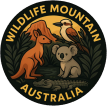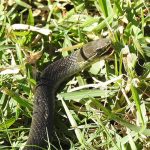MARSH SNAKE
The Marsh Snake:
In the lush, verdant landscapes of eastern Australia, a slender, elusive creature slithers through the underbrush—the Marsh Snake, scientifically known as Hemiaspis signata. This snake, also referred to as the Black-bellied Swamp Snake, inhabits the moist, well-vegetated areas of Queensland and New South Wales, weaving its way through rainforests, wetlands, and the edges of creeks and dams.
Physical Characteristics
The Marsh Snake’s appearance is both distinctive and subtle. Its back is a uniform shade of brown, olive, or black, seamlessly blending with the dark grey or black of its belly. A striking feature is the pair of narrow, pale-yellowish stripes on each side of its face: one runs from the snout, through the eye, and onto the neck, while the other extends from the snout to the corner of the mouth. Juvenile Marsh Snakes often display a darker head compared to their bodies. Typically, they measure around 50 cm in length, though some individuals can grow up to 70 cm. Their smooth, semi-glossy scales add to their sleek appearance.
Habitat and Distribution
Preferring moist, well-vegetated environments, Marsh Snakes are commonly found in rainforests, wet sclerophyll forests, and areas adjacent to creeks, dams, and wetlands. They are particularly prevalent in regions with low-lying, seasonally flooded areas. In urban settings, they may be spotted in damp gardens, often sheltering under rocks, sheets of bark, or thick vegetation.
Behaviour and Diet
Primarily diurnal, Marsh Snakes are most active during daylight hours but may also venture out at night during hot weather. They are adept swimmers and often shelter under rocks, sheets of bark, and thick debris. Their diet mainly consists of small frogs and lizards, which they hunt with agility and precision.
Venom and Human Interaction
While the Marsh Snake is mildly venomous, bites are rare and typically occur when the snake is handled or threatened. Bites can cause local symptoms such as pain and swelling, with more general reactions like headaches and nausea also recorded. Immediate first aid is essential, and medical attention should be sought promptly.
Conservation Status
The Marsh Snake is currently listed as a species of least concern by the International Union for Conservation of Nature (IUCN). However, like many native species, it faces threats from habitat loss and degradation. Preserving their natural habitats is crucial for maintaining the delicate balance of Australia’s ecosystems.
The Marsh Snake, with its distinctive markings and secretive nature, plays a vital role in controlling populations of small amphibians and reptiles. Its presence in the rich tapestry of Australia’s wildlife underscores the importance of conserving these unique creatures and the habitats they inhabit.

